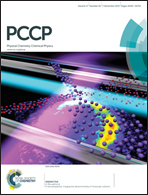Sign change of magnetoresistance in Gd-doped amorphous carbon granular films†
Abstract
Gd/C granular films with 11% Gd were fabricated by facing-target magnetron sputtering at room temperature and then annealed at 300–650 °C for 1.5 h. A magnetoresistance of −82% was obtained in the Gd/C films annealed at 650 °C at 3 K under a magnetic field of 50 kOe. A sign change of the magnetoresistance from negative to positive and then back to negative was observed in all samples as the temperature decreases. Grain boundary scattering effects, wave-function-shrinkage, cotunneling and Gd–Gd interactions account for the mechanisms of the magnetoresistance effects in different temperature regions. The sign of the magnetoresistance also varies as the magnetic field increases. At the transition temperature of 25 K, the wave-function-shrinkage effect competes with cotunneling and Gd–Gd interactions at different magnetic fields. The competition between the wave-function-shrinkage effect and the grain boundary scattering effect is approximately at the transition temperature of 100 K. The temperature range of positive magnetoresistance expands and transition temperatures are changed as the annealing temperature increases. It is related to the expansion of the temperature region for the wave-function-shrinkage effect which occurs in the Mott variable range hopping conduction mechanism.


 Please wait while we load your content...
Please wait while we load your content...